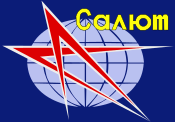Soyuz 16
| Mission type | Test flight for ASTP mission |
|---|---|
| Operator | Soviet space program |
| COSPAR ID | 1974-096A |
| SATCAT no. | 07561 |
| Mission duration | 5 days 22 hours 23 minutes 35 seconds |
| Orbits completed | 95 |
| Spacecraft properties | |
| Spacecraft | Soyuz 7K-TM No.4 |
| Spacecraft type | Soyuz 7K-TM |
| Manufacturer | NPO Energia |
| Launch mass | 6680 kg[1] |
| Landing mass | 1200 kg |
| Crew | |
| Crew size | 2 |
| Members | Anatoly Filipchenko Nikolai Rukavishnikov |
| Callsign | Буран (Buran - "Blizzard") |
| Start of mission | |
| Launch date | 2 December 1974, 09:40:00 Site 1/5[2] |
| End of mission | |
| Landing date | 8 December 1974, 08:03:35 UTC |
| Landing site | 30 km of the northeast of Arkalyk, Kazakhstan |
| Orbital parameters | |
| Reference system | Geocentric orbit[3] |
| Regime | Low Earth orbit |
| Perigee altitude | 177.0 km |
| Apogee altitude | 223.0 km |
| Inclination | 51.7° |
| Period | 88.4 minutes |
 Salyut program insignia | |
Soyuz 16 (
Crew
| Position | Cosmonaut | |
|---|---|---|
| Commander | Second and last spaceflight | |
| Flight Engineer | Second spaceflight | |
Backup crew
| Position | Cosmonaut | |
|---|---|---|
| Commander | ||
| Flight Engineer | ||
Reserve crew
| Position | Cosmonaut | |
|---|---|---|
| Commander | ||
| Flight Engineer | ||
Mission parameters
- Mass: 6,680 kg (14,730 lb)[1]
- Perigee: 177.0 km (110.0 mi)[3]
- Apogee: 223.0 km (138.6 mi)
- Inclination: 51.7°
- Period: 88.4 minutes
Background
The Soyuz 16 mission was the final rehearsal and first crewed mission in a program which culminated in the
Early concepts for a joint flight included the docking of a
Three test flights of an uncrewed version of the ASTP spacecraft were flown: Kosmos 638, launched 3 April 1974; Kosmos 652, launched 15 May 1974; and Kosmos 672, launched 12 August 1974. These three flights, and Soyuz 16, were all launched with an improved version of a Soyuz booster.[5]
Mission highlights
In an unprecedented move, Soviet planners offered to inform their NASA counterparts of the time of the launch, as long as they did not reveal that time to the press. NASA officials refused to agree to that condition and, accordingly, were informed of the launch an hour after it occurred, on 2 December 1974.[4]
During the flight,
The craft landed 8 December 1974, near Arkalyk and was hailed a complete success.[5] The mission duration, six days, matched the ASTP mission duration to within 10 minutes.[4]
References
- ^ a b "Display: Soyuz 16 1974-096A". NASA. 14 May 2020. Retrieved 11 October 2020.
 This article incorporates text from this source, which is in the public domain.
This article incorporates text from this source, which is in the public domain.
- ^ "Baikonur LC1". Encyclopedia Astronautica. Archived from the original on 15 April 2009. Retrieved 4 March 2009.
- ^ a b "Trajectory: Soyuz 16 1974-096A". NASA. 14 May 2020. Retrieved 11 October 2020.
 This article incorporates text from this source, which is in the public domain.
This article incorporates text from this source, which is in the public domain.
- ^ ISBN 0-517-56954-X.
- ^ ISBN 0-87201-848-2.

